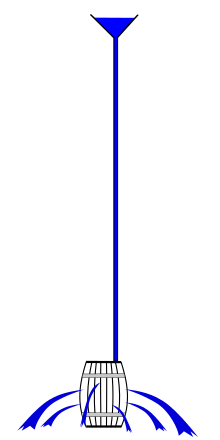Hydrostatic paradox
The hydrostatic paradox , also Pascal's (or Pascal's ) paradox (after Blaise Pascal ), is the paradox that the gravity pressure (hydrostatic pressure) that a liquid in a vessel causes on the bottom of the vessel depends on the filling level ( mirror height) of the liquid, but not of the shape of the vessel and thus the amount of liquid contained. This is synonymous with liquids filling the space available to them everywhere up to the same height, the mirror. If there are foreign bodies in the liquid, it flows around it to compensate for the level, as long as there is some liquid-filled connection, including under the level. The physical basis is the hydrostatic pressure . He calculates to
with ( formula symbol )
- = Density [for water : ρ ≈ 1,000 kg / m³]
- = Acceleration due to gravity [for Germany: g ≈ 9.81 m / s²]
- = Height (in this case the liquid level )
- = Hydrostatic pressure ( ) as a function of the height ( ) of the liquid level .
- = Ambient pressure or atmospheric pressure
Explanation
In all vessels with the same fill level, the same liquid pressure acts on the vessel bottom at the same level, regardless of the base area and the vessel geometry. As a consequence, the same level occurs in communicating tubes , regardless of the tube geometry.

with a long, thin pipe (up to the second floor). A normal, intact barrel leaked, demonstrating the enormous water pressure.
For a liquid at rest in a homogeneous gravitational field , neglecting the capillary effect , the hydrostatic pressure depends only on the depth below the liquid surface. If the water level in different ascending branches of the communicating tubes were different, the liquid in them would not be in equilibrium. In this case, the fluid in the cross-connections will flow until equilibrium is established (in the presence of friction). Then the liquid is the same in all branches. The air pressure does not have to be taken into account, as it is the same in a very good approximation in the entire area of the communicating tubes.
The mass of the water and thus its weight in the various branches of the communicating tubes is very different. This weight also creates forces that are borne by the vessel or additional supports. For the reasons described above, however, this weight cannot cause any difference in the water levels of the various branches.
In a vessel with liquid, the forces caused by the liquid and the opposing forces of the vessel wall cancel each other out. This equilibrium of forces can be used to illustrate how the different forces act, even though the same hydrostatic pressure prevails everywhere at the same depth. At an interface between the liquid and the vessel, the liquid is at every point, just as inside the liquid, under a certain hydrostatic pressure depending on the depth below the liquid level. This causes a force on each patch that is perpendicular to the patch and outward. As long as the vessel wall is intact, it creates a counter pressure that cancels the force of the hydrostatic pressure. If an opening breaks at a point in the vessel where the hydrostatic pressure is greater than zero, liquid escapes at this point and is accelerated by the forces due to the pressure difference. As a result, the liquid splashes away from the opening and, depending on the position of the opening, also upwards. After exiting the opening, there is no longer any hydrostatic pressure acting on the liquid, and consequently no force whatsoever due to the hydrostatic pressure.
application
- A water tower is a reservoir that is placed higher than the water consumers. The difference in height causes the water pressure at the tapping points.
- The hose level is an ideal instrument for measuring height differences in distant places. The functional principle is based on the communicating pipes: The water level is the same in both vertically positioned ends of a hose.
- In the artesian well , the water comes up by itself at a well hole.
- all hydraulic equipment
literature
- Wolfgang Demtröder : Experimental Physics 1 - Mechanics and Heat . 2nd Edition. Springer-Verlag, Berlin / Heidelberg / New York 2001, ISBN 3-540-64292-7
- Willi Bohl, Wolfgang Elmendorf: Technical fluid mechanics . 13th edition. Vogel-Buchverlag, Würzburg, ISBN 3-8343-3029-9
- Robert Freimann: Hydraulics for civil engineers: Fundamentals and applications . 3. Edition. Carl Hanser Verlag, Munich, ISBN 978-3-446-43799-9
Web links
Individual evidence
- ^ Lew Dawidowitsch Landau , Jewgeni Michailowitsch Lifschitz : Statistical Physics. Part I. Akademie Verlag, Berlin 1979/1987, ISBN 3-05-500069-2 , p. 70.









